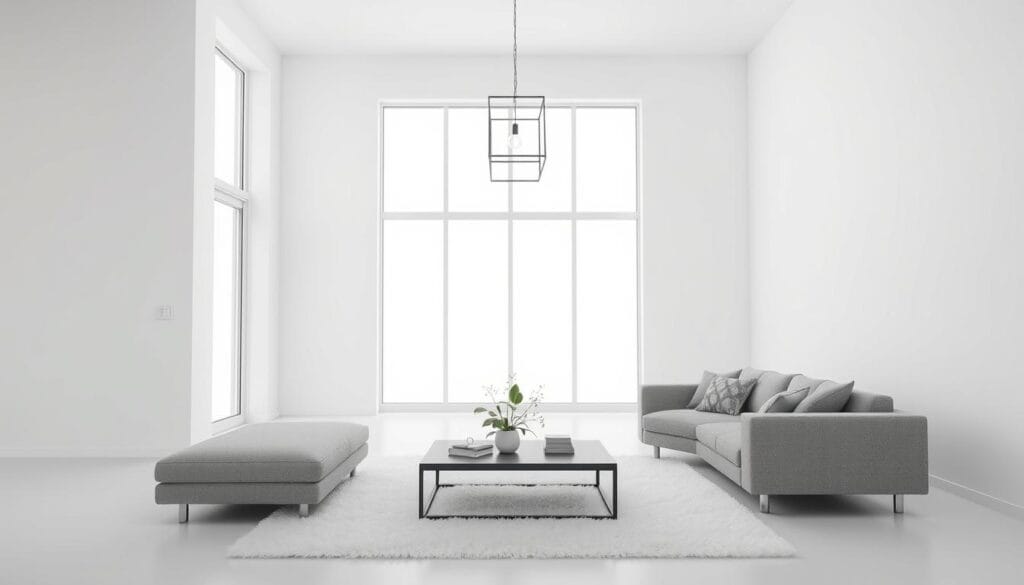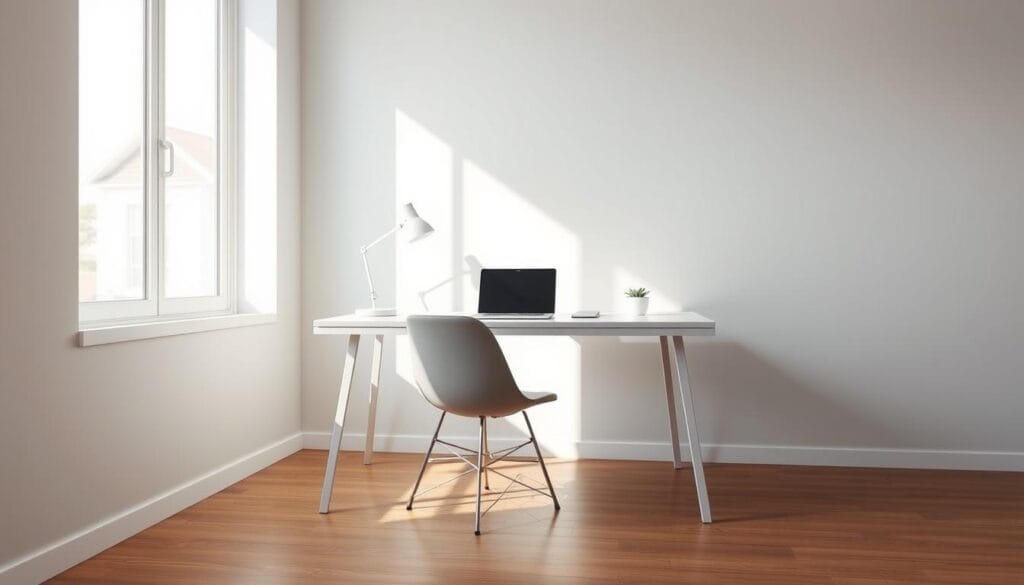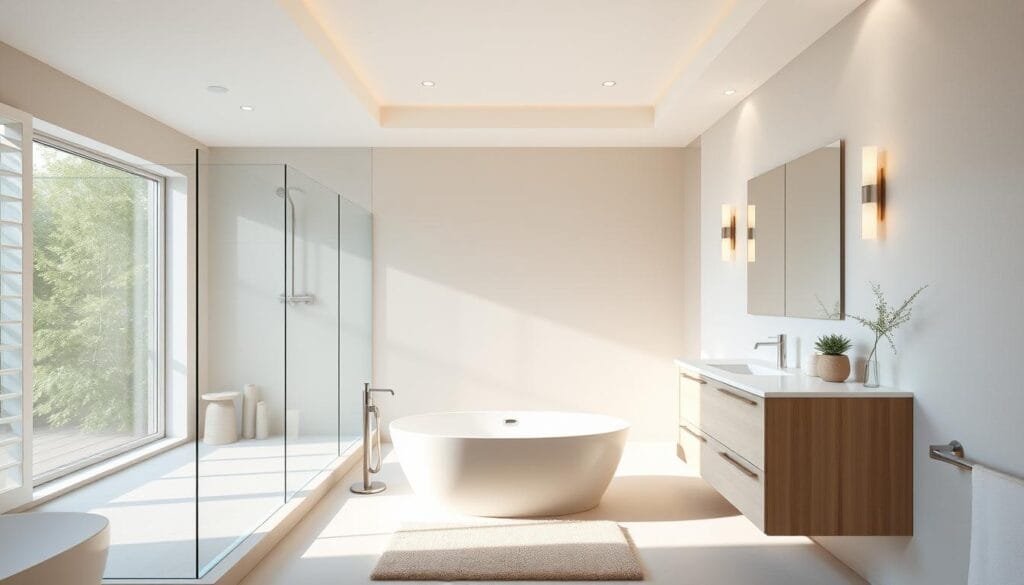A coffee chat led to redoing my whole house. My friend was shocked by my messy living room. She mentioned a simple, tidy space brings peace.
Together, we explored modern minimalist design. We loved sleek decor and designs that made rooms calm. Many homeowners love using one color to keep things peaceful. We found natural light and simple designs made our homes peaceful and open.
Many designers love open layouts for a clean look, focusing on clarity and calmness. So, if you’re starting or refining your minimalist space, remember: simplicity brings inner peace.
Understanding Modern Minimalist Design
Contemporary minimalism has changed a lot, mixing beauty and practical use in one design idea. This style follows the “less is more” belief. It makes spaces calming, tidy, and eye-catching right away.
Definition and Key Principles
Minimalism focuses on being simple, using clean lines, and having soft colors. It aims to make peaceful places where everything has a reason. This cuts down on mess and too much to look at. It’s not just about design, but living with only what you need.
Adding minimalist design parts means everything adds beauty without being too much.
Historical Background
Modern minimalism started in the mid-20th century and was shaped in the ’60s and ’70s. It was part of the minimalist art scene after World War II. It became really popular in the 1980s, thanks to people like Ludwig Mies van der Rohe who said “less is more.”
The idea of “function over form” was key, focusing on being useful and simple. This was a big change from the fancy styles before.
Importance in Today’s Interiors
Nowadays, minimalism is super important. It matches our wish to live simply and care for the environment. Minimalism helps make peaceful spots that are good for relaxing and being mindful. Spaces with minimalist design look good together and are smart about storing things. This keeps places looking nice and useful.
Modern homes with this style often have open spaces and big windows. This makes them feel welcoming and full of light.
Key Features of Minimalism
Starting a minimalism journey includes choosing simplicity and intention. Key features are a minimalist color scheme and clean, simple rooms. These qualities not only look good but also make living spaces calm.
Color Palette
The colors used in minimalism are mostly neutral, like beige, brown, and cream. These colors make a space welcoming and peaceful. Adding different shades in this simple color scheme makes rooms feel lively without being too much. Using a few bright colors can add a fun contrast.
Functionality and Space
Being functional is important in minimalist design. It means everything has a use and adds to the room’s look and purpose. Getting rid of extra stuff lets us focus on what’s important. For example, a kitchen in Central Park got 20% more storage from being designed to work better. These designs lead to spaces that are useful and look good.
Minimalist areas also keep things open and flowing. They often have open floor plans. This makes moving around easy and connects different parts of the home. It makes homes feel together and welcoming.
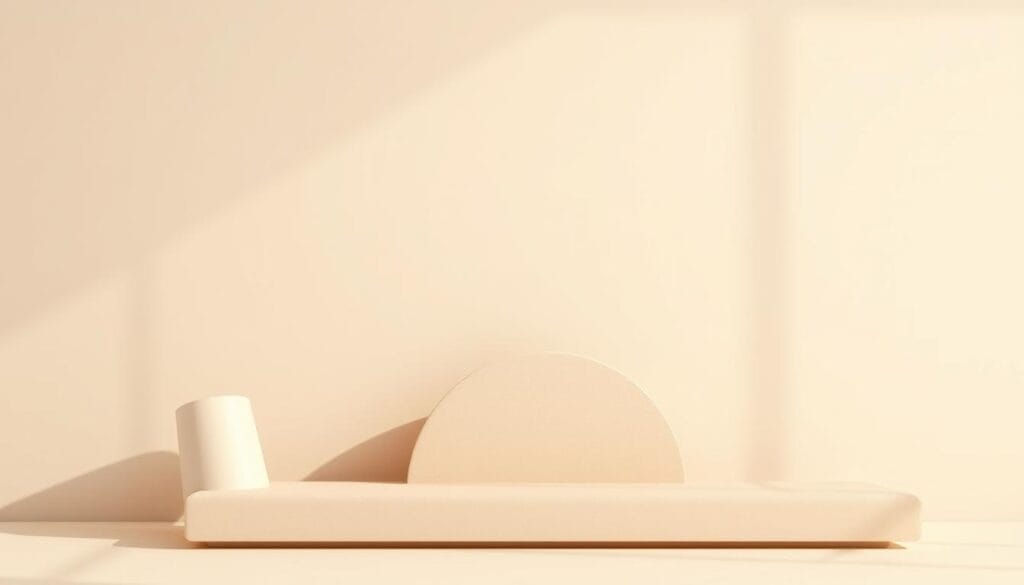
Use of Natural Light
Using a lot of natural light is key in minimalist design. Big windows and smart layout let in lots of sunlight. This cuts down on artificial light and makes rooms feel open and bright. It shows off the minimalist style, making your home look and feel better.
If you want to learn more about minimalist home design, here’s a great guide on the main features. It’s a useful read to better understand and use these ideas in your space.
Selecting Minimalist Furniture
Choosing minimalist furniture is about keeping it simple and practical. Look for items that simplify your space but are still useful. Aim for a clutter-free, calming environment by selecting the right pieces.
Essential Furniture Pieces
Begin with basic items that mix function and style. For a minimalist living room, think of a sleek sofa, a stylish coffee table, and a plain rug. In the bedroom, go for a straightforward bed frame and minimal side tables.
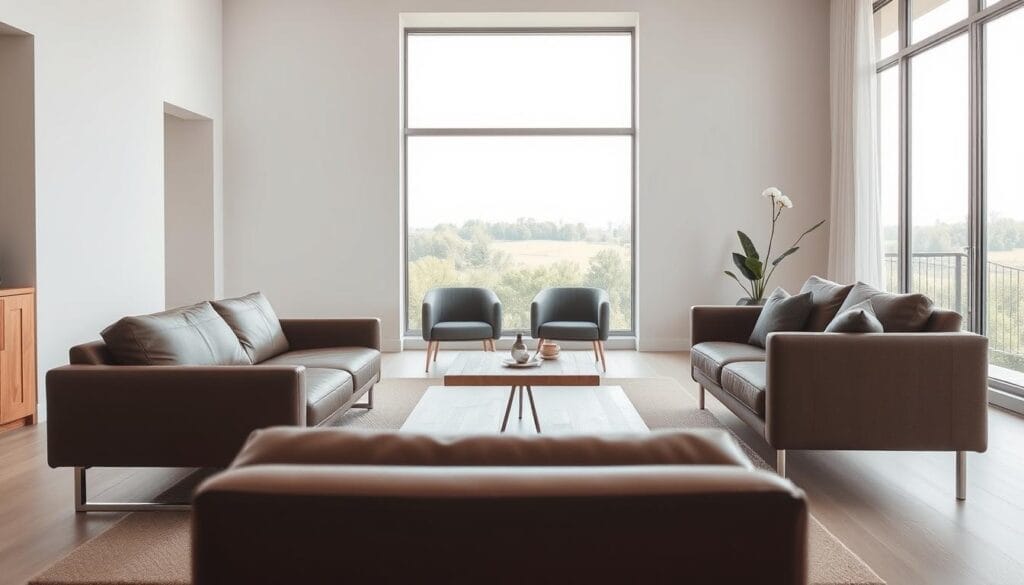
Material Selection
Picking the right materials is key for minimalist furniture. Opt for large porcelain slabs for a smooth, unified look. Adding natural materials like wood and stone brings in warmth and texture. Stick to calm colors like white, beige, and black.
Multi-functional Designs
Choosing furniture with multiple uses is important. Look for items like a storage ottoman, a table that’s also a workspace, or a sofa bed. These pieces boost function without ruining the minimalist style.
By carefully choosing minimalist pieces and versatile designs, you can make a stylish, efficient space. Go for simple lines, neutral colors, and useful furniture to create a relaxed, inviting home.
Minimalist Color Schemes
Creating the perfect minimalist color schemes means finding the right mix of neutral tones and accent colors. This careful balance gives an elegant look that’s both calm and interesting. It makes your home feel peaceful.
Neutral Tones
Neutral tones are key to minimalist color schemes, usually around 70-80% of the palette. Colors like white, beige, and gray create a calm background. For example, Revere Pewter HC-172 in living rooms blends beige’s warmth with gray’s modern touch. This mix feels cozy and stylish.
Bedrooms do well with soft, muted colors like pale blue or lavender. These colors help make the room more relaxing and can improve sleep by up to 20%. Kitchens in white and light gray make the space feel cleaner and bigger by up to 30%.
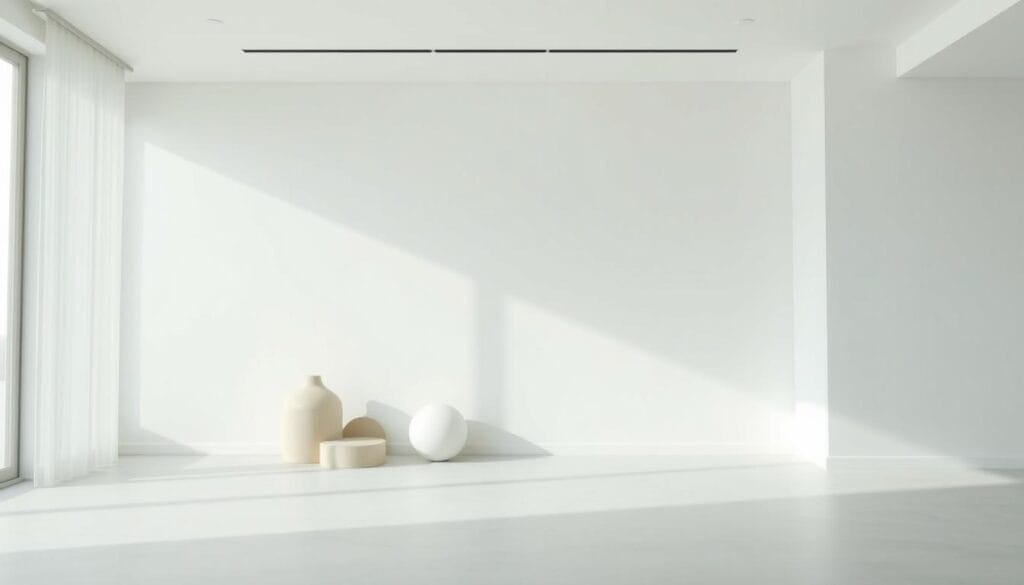
Accent Colors
Accent colors add life and personality to minimalist designs without adding clutter. They usually are 20-30% of the color scheme. In industrial designs, bold primary colors can add 20-30% more interest. Living spaces may use small colorful items like pillows and artwork for a splash of color.
In modern designs, dark shades like Black Tar 2126-10 can offer a dramatic yet simple look.
Creating a Harmonious Look
To get a harmonious look in minimalist design, mix neutral and accent colors with natural light. Soft, muted tones can cut stress by 25%, making you feel good. Adding different whites like in the Benjamin Moore Off White Collection can make a place welcoming.
Using reflective surfaces and creative paints, such as satin finishes, adds depth. This ensures your minimalist color schemes uplift every aspect of your design.
Lighting in Minimalist Design
Understanding modern minimalist design shows us how crucial lighting is. It makes your space look better and helps it work better too. By choosing the right minimalist lighting, we can change your home with smart lighting choices.
Types of Lighting
Lighting in minimalist interiors is all about being simple yet effective. We have many options like recessed lighting, minimalist chandeliers, and pendant lights. Recessed lighting fits nicely into ceilings and walls, enhancing straight lines. Minimalist chandeliers are simple but make a bold statement. Pendant lights are great for brightening up areas like kitchens and dining rooms.
Importance of Natural Light
Natural light is a big deal in minimalist design. Using big windows or glass panels makes spaces feel open and big. Around 60% of interior designers say natural light is key in minimalist interiors. It makes rooms brighter, more welcoming, and seem larger.
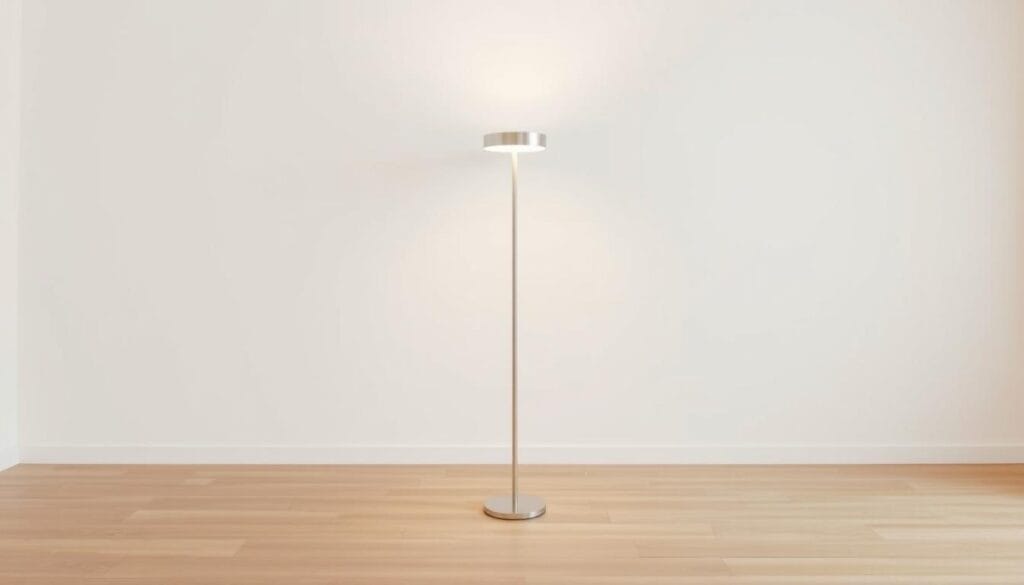
Layering Light Sources
Adding layers of light can make minimalist design even better. Using different types of light adds depth and makes your home more useful. For example, mixing ambient lighting with sconces or floor lamps creates a nice balance. Did you know mixing metal wall sconces can make your room look taller? By choosing lights carefully, your home becomes both stylish and comfy.
Textures and Materials
In modern minimalist design, textures matter a lot. They make simple spaces feel alive and rich. Using different materials adds depth and avoids a bland look.
Choosing the Right Textures
It’s important to be smart about mixing textures. Interior designers say mixing them keeps a space interesting. Choices like boucle, velvet, and seagrass wallpaper are favorites.
High-pile rugs add warmth. Putting a wool rug over a sisal one adds more texture.

Common Minimalist Materials
Furniture looks great in wood, travertine, marble, and steel. They’re simple but add texture. Travertine is loved for its look and price, adding to a room’s feel.
Fabrics like boucle and velvet add luxury to sofas and chairs. Natural stuff like wood, silk, and linen keep things balanced. Learn more from this in-depth guide.
Balancing Texture and Simplicity
Finding the right mix of texture and simplicity is key. Textures define things in a monochromatic scheme. Neutral textiles like linen and cotton keep things light but detailed.
Minimalist materials make your home look and function well. Lighting to furniture, it’s about balancing textures to make spaces feel welcoming and chic.
Art and Decor in Minimalism
Adding art and decor to a minimalist design boosts the calming feel it aims for. Carefully chosen art and sleek decor can make your area more visually appealing. This is done while keeping things simple and elegant.
Selecting Art that Compliments
Finding the right art piece is vital in a minimalist design. Look for art in soft tones like white, grey, beige, and black. These fit well with the typical minimalist color scheme. These colors mix well in any room and add elegance without clashing with what’s already there.
Also, look for art that’s simple and uses lots of empty space. Minimalist art follows the “less is more” idea. This brings a peaceful feeling. Textured art pieces bring warmth and depth. This boosts the minimalist vibe.
Statement Pieces vs. Minimal Decor
In minimalist design, it’s important to balance bold pieces and simpler decor. A large, minimalist art piece can make a strong statement. This adds drama without making the space feel too busy. Smaller pieces or sleek decor can be put together to look neat and unified.
Make sure any bold pieces fit with minimalist design rules. Feel free to try vivid colors and patterns in a modern minimalist look. They provide contrast but still stick to simplicity.
The Role of Greenery
Plants are crucial in minimalist home decor. Adding plants brings a natural touch, making the sleek decor look alive and welcoming. Plants such as succulents or ferns work as natural artworks. They add to the design while also being good for you.
Using plants in a minimalist space adds color and texture. It matches well with the minimalist goal of a calm, tidy setting. Thus, plants perfectly match minimalist art and decor. This creates a peaceful and balanced living area.
Space Planning Techniques
Learning how to plan your space can make your home feel peaceful instead of messy. Whether your home is big and open or small and cozy, knowing how to use space wisely is important. This way, you can design rooms that are both functional and stylish.
Open Concept vs. Defined Spaces
Choosing between an open layout or separate rooms is a big step in planning your space. Open floor plans make everything feel bigger and brighter, which is why many architects love them. But having separate areas can be better for privacy and for arranging your space around specific activities.
Importance of Flow
Good flow makes a room easy to use and pleasant to be in. Using the same floor materials can help different rooms blend together nicely. This trick makes your home seem bigger. It also makes moving from one place to another simple, thanks to pathways that are both open and cozy.
Making Small Spaces Work
Smart planning is key for getting the most out of a small area. You can use spaces like recessed walls to fit more into your room. Adding things like shelves and furniture with legs can really increase how much you can store. This keeps everything looking neat. For tips on doing more with less, visit 8 Ways to Maximize Space in a Small Living Room.
Designing small rooms well isn’t just about making things smaller. It’s about using every part of your space to create a place that’s both nice to look at and easy to live in.
Minimalism in Different Rooms
Making your home’s rooms minimalist can lead to peaceful and useful areas without too much stuff. We’ll explore how to make your living room, kitchen, dining areas, and bedroom minimalist.
Living Room Essentials
For a minimalist living room, focus on simplicity and purposeful items. Begin with furniture that is low to the ground. This makes ceilings appear taller, a choice 70% of minimalists love. Use neutral colors, like whites and earth tones, and add one colorful item for character. Natural light is key too. It makes the room look bigger, which 80% of minimalist designs aim for.
Kitchen and Dining Areas
Minimalist kitchens and dining rooms should be all about simplicity and use. Choose cabinets that hide things away to keep surfaces clean. Many modern minimalists, about 60%, like adding wood for a cozy feel. Use neutral shades with one standout piece, like a special table or light, for a unified and simple look.
Bedroom Design Principles
A minimalist bedroom is all about peace and comfort. Pick soft, quiet colors; 90% of minimalist spaces do. Think of using natural stuff like linen sheets and wood furniture for calm. A bed with storage is smart for saving space, a trick 85% of small room designs use. Also, pick art that fits the minimalist style, as 65% of designers recommend.
Sustainable Minimalism
Sustainable minimalism means using eco-friendly design and cutting down waste. It highlights the big pluses of living sustainably. Let’s look into how you can live simply, beautifully, and green.
Eco-Friendly Materials
Choosing sustainable materials is the first step. Use things like bamboo, reclaimed wood, and recycled plastics. They make your space minimal yet meaningful. Picking suppliers close by also cuts CO2 from shipping, boosting your green efforts.
Choosing eco-friendly, quality furniture helps your space and the air quality. It avoids harmful chemicals. Opting for items that last over throwaway ones is central to sustainable minimalism. 60% of people now prefer buying durable goods.
Reducing Waste
Cutting down waste is key to eco-friendly minimalism. Upgrading what you already have values sustainability and skill. It lessens the demand for new stuff, lowering your eco-footprint. Also, furniture that serves more than one purpose fits minimalist ideals well.
The Konmari method tells us to keep only what makes us happy. It cuts clutter and supports a simpler lifestyle. 55% of homeowners find minimalism makes upkeep and cleaning easier. This trims waste and boosts life quality.
Benefits of Sustainability in Design
Sustainable design in a minimalist home has many upsides. Smart technologies like efficient heating systems and water-saving faucets cut down on power and water use. For example, heating systems that adjust on their own keep energy waste low.
Using natural light reduces electric use. In minimalist spaces, light walls and mirrors spread natural light, seeming to expand the space and save energy. Indoor plants clean and moisten the air, adding beauty that’s also practical.
Sustainable minimalism makes spaces appealing and clutter-free, and it’s good for you too. It can make homes feel up to 25% bigger, which is great for small places. Choosing quality over quantity supports a clean, green living area.
| Key Practice | Benefits |
|---|---|
| Using Eco-Friendly Materials | Reduces harmful emissions, improves indoor air quality |
| Reducing Waste | Promotes sustainability, reduces environmental impact |
| Incorporating Smart Technology | Reduces energy and water consumption |
| Maximizing Natural Light | Enhances energy efficiency, creates more spacious feel |
Common Mistakes to Avoid
As we work towards a mindful minimalist design, it’s key to watch out for traps. Making design mistakes stops us from having a functional and good-looking home. Let’s explore some common slip-ups by homeowners.
Over-Decorating Spaces
Decorating too much is an easy mistake. Sadly, 70% of homeowners keep decor they don’t even like, making spaces feel crowded. Remember, “less is more” should be your decorating rule. Go for simple, meaningful decor items.
Choosing Inappropriate Colors
Choosing the right colors is super important for minimalist design. But, many pick colors that clash or don’t fit the minimalist style. Off-white colors can make a room feel warm and deep, solving the cold look issue. Plus, adding plants can make the room look 40% more livable.
Ignoring Functionality
A big issue is focusing only on looks, not use. About 80% miss checking if furniture fits well in their design. Everything should be both beautiful and useful. Planning and budgeting well can cut costs by 30%. If needed, getting help from a pro can avoid costly errors by 40%.
Here’s a simple guide to avoid these mistakes:
| Mistake | Impact | Tips to Avoid |
|---|---|---|
| Over-Decorating | Cluttered, overwhelming space | Choose meaningful items, follow “less is more” principle |
| Inappropriate Colors | Cold, uninviting environment | Use off-white shades and incorporate natural elements |
| Ignoring Functionality | Unbalanced and impractical design | Focus on proportion, plan and budget properly |
Resources for Modern Minimalist Design
Modern minimalist interior design is more than just a trend. It symbolizes a lifestyle of simplicity, functionality, and beauty. As it becomes more popular, we see why many love neutral colors, clean lines, and natural materials. If you’re interested in this design style, we’ve gathered a list of great resources for you. Let’s check out the top minimalist design resources to help transform your space!
Books and Magazines
Dive into minimalist design with helpful books and magazines. Titles like “The Joy of Less” by Francine Jay and “Essentialism” by Greg McKeown offer deep insights into decluttering and living with purpose. For design tips, “Elements of Style” by Erin Gates is very useful. Also, magazines like “Dwell” and “Architectural Digest” often highlight beautiful minimalist spaces. These books and magazines are excellent for adding elegance and simplicity to your home.
Online Platforms and Inspiration
The internet is full of inspiration for minimalist design fans. Pinterest and Instagram are perfect for finding ideas from around the world. Follow hashtags like #minimalistdesign and #simpleliving to keep up with trends. Websites like “Houzz” and “Apartment Therapy” are great for stylish minimalist interiors and tips. Plus, online courses from platforms like “Udemy” and “Skillshare” are ideal for learning more about minimalist design.
Professional Designers and Consultations
At times, a professional’s help is needed to realize our minimalist dreams. Working with skilled interior designers offers personalized minimalist design advice. Famous designers like Marie Kondo, with her KonMari method, and Joanna Gaines, known for her modern farmhouse style, provide great inspiration. Also, IKEA and West Elm offer design services to help create functional, beautiful spaces. These experts offer valuable guidance, making your minimalist journey successful and smooth.

